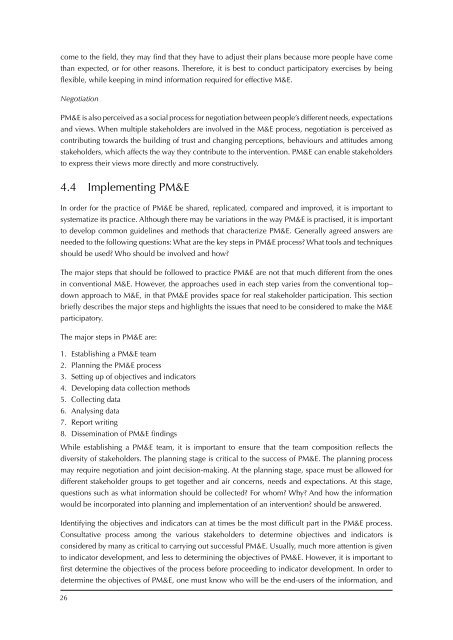A guide for practitioners
A guide for practitioners
A guide for practitioners
You also want an ePaper? Increase the reach of your titles
YUMPU automatically turns print PDFs into web optimized ePapers that Google loves.
come to the field, they may find that they have to adjust their plans because more people have comethan expected, or <strong>for</strong> other reasons. There<strong>for</strong>e, it is best to conduct participatory exercises by beingflexible, while keeping in mind in<strong>for</strong>mation required <strong>for</strong> effective M&E.NegotiationPM&E is also perceived as a social process <strong>for</strong> negotiation between people’s different needs, expectationsand views. When multiple stakeholders are involved in the M&E process, negotiation is perceived ascontributing towards the building of trust and changing perceptions, behaviours and attitudes amongstakeholders, which affects the way they contribute to the intervention. PM&E can enable stakeholdersto express their views more directly and more constructively.4.4 Implementing PM&EIn order <strong>for</strong> the practice of PM&E be shared, replicated, compared and improved, it is important tosystematize its practice. Although there may be variations in the way PM&E is practised, it is importantto develop common <strong>guide</strong>lines and methods that characterize PM&E. Generally agreed answers areneeded to the following questions: What are the key steps in PM&E process? What tools and techniquesshould be used? Who should be involved and how?The major steps that should be followed to practice PM&E are not that much different from the onesin conventional M&E. However, the approaches used in each step varies from the conventional top–down approach to M&E, in that PM&E provides space <strong>for</strong> real stakeholder participation. This sectionbriefly describes the major steps and highlights the issues that need to be considered to make the M&Eparticipatory.The major steps in PM&E are:1. Establishing a PM&E team2. Planning the PM&E process3. Setting up of objectives and indicators4. Developing data collection methods5. Collecting data6. Analysing data7. Report writing8. Dissemination of PM&E findingsWhile establishing a PM&E team, it is important to ensure that the team composition reflects thediversity of stakeholders. The planning stage is critical to the success of PM&E. The planning processmay require negotiation and joint decision-making. At the planning stage, space must be allowed <strong>for</strong>different stakeholder groups to get together and air concerns, needs and expectations. At this stage,questions such as what in<strong>for</strong>mation should be collected? For whom? Why? And how the in<strong>for</strong>mationwould be incorporated into planning and implementation of an intervention? should be answered.Identifying the objectives and indicators can at times be the most difficult part in the PM&E process.Consultative process among the various stakeholders to determine objectives and indicators isconsidered by many as critical to carrying out successful PM&E. Usually, much more attention is givento indicator development, and less to determining the objectives of PM&E. However, it is important tofirst determine the objectives of the process be<strong>for</strong>e proceeding to indicator development. In order todetermine the objectives of PM&E, one must know who will be the end-users of the in<strong>for</strong>mation, and26

















